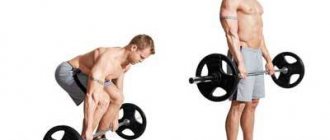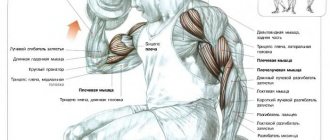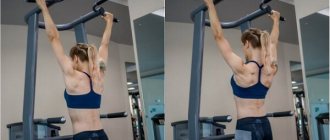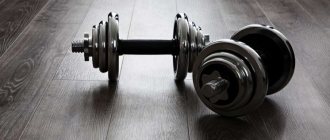© Prostock-studio — stock.adobe.com
Share:
What you need
- horizontal bar
Can't go to the gym regularly? Don't fall into despair! You can fully train without going far from home with the help of the simplest sports equipment - a horizontal bar. A well-designed horizontal bar training program for beginners allows you to work out almost all the muscles of the torso: latissimus dorsi, biceps, triceps, deltoids and abs.
The benefits of exercising on the horizontal bar
There are dozens of varieties of exercises on the horizontal bar: pull-ups in various variations, push-ups, hanging leg raises, power-ups and many others. Finding the ones that suit your purposes won’t be difficult. With the help of the complexes described in the article, you will gain muscle mass, become stronger and improve your relief. However, methodicality and consistency are important in everything, and training on the horizontal bar with your own weight is no exception.
In this article we will analyze several of the best training programs on the horizontal bar, answer the question of how to create an individual program, and give useful tips and recommendations.
Benefits of training
It is no coincidence that exercises on the horizontal bar and parallel bars form the basis of general physical training (GPP). Men are taught to practice on the horizontal bar from childhood: both at school and in any sports section. In the army and in physical education at the university, these exercises are also not ignored. How are they useful and what are their main advantages?
- Availability and prevalence. There are horizontal bars in every yard: you don’t have to waste time getting to the training place. In large cities there are more and more well-equipped workout areas with horizontal bars of different heights and widths, parallel bars, rings, ladders for grip training, ropes and other equipment. All this is free. You can do it even simpler - buy or make a horizontal bar yourself and play sports without leaving your home.
- Variety of the training process. If you think that training on the horizontal bar is limited to just pull-ups, you are deeply mistaken. Having a certain physical training, you can work out almost all the muscles of the torso on the horizontal bar.
- Safety. If you follow the correct exercise technique, the risk of injury is minimized. The rules are simple: during pull-ups and other pulling exercises, do not tilt your head back too much, do not round the thoracic spine, and do not make circular movements with your shoulders.
- Increased muscle mass and strength. On the horizontal bar it is easy to implement the principle of progression of loads, which will make you bigger and stronger. Also, training with your own weight strengthens ligaments and tendons, which increases strength potential.
- Save time. Training on the horizontal bar will not take much time. 25-30 minutes is enough to complete the entire planned amount of work.
Positive effect on the body
It has been proven that prolonged hanging on the horizontal bar without the use of wrist straps relieves hypertonicity in the spinal extensors, strengthens the grip, improves posture and reduces the risk of back injuries.
Continuous work with your own weight allows the muscles to overcome pain and a burning sensation in the muscles. Refusal comes much later. Over time, athletes adapt to such loads, and training on the horizontal bar is much easier.
Among other things, playing sports in the fresh air is much healthier for the body than in a stuffy gym. A higher oxygen content in the air promotes rapid recovery between approaches and improves the oxidation process of adipose tissue.
Contraindications
Not all athletes will benefit from training on the horizontal bar. It is widely believed that hanging on the horizontal bar has almost miraculous properties and helps with hernias and protrusions. Unfortunately, this is far from the case.
If you have such problems with the spine, you should not train on the horizontal bar at all, since a long time in an extended position can aggravate the situation.
Be sure to consult with a qualified physician before beginning full-scale exercise. Only he will competently answer the question of how to play sports and not harm your health.
It is also not recommended to exercise on horizontal bars for those who have recently had sprains or torn ligaments in their shoulders or elbows. Hanging for a long time will lead to pain, especially if your own weight is above average. You risk recurrence of the injury.
Varieties of pull-ups on the horizontal bar
You can do pull-ups on the bar in different ways. Each of them has its own characteristics that are worth knowing about in order to competently create a training plan and get the maximum benefit from your classes. Do you know all the types of pull-ups that will help pump up your muscles?
Basic pull-up technique
To take the starting position, you need to hang on the bar using a grip selected in accordance with the purpose of the lesson. While hanging, it is important to keep your shoulders rigid, keeping your shoulder joints down and your back muscles tight. When relaxing the shoulder area, there is a high probability of injury to the joints.
Professionals advise not to hang from straight arms, but to bend your elbows slightly (“soft elbows”). Your feet should not touch the floor; your ankles can be crossed one behind the other.
- Taking a deep breath, with a powerful muscular effort, pull the body towards the crossbar. The rise occurs as you exhale.
- Having reached the top position (in the classic version, this is the moment of bringing the chin to the bar; with targeted training of the biceps, it occurs a little earlier). Here they pause for a second, further bringing their shoulder blades together.
- Inhaling, straighten your arms under control, returning to their original position.
Do 8–15 reps in 3–5 sets.
V
When doing pull-ups, there is no need to allow pendulum swings of the body: this will “loose” the joints, activate the force of inertia and reduce the effectiveness of the exercise.
Direct and reverse grip
The classic version is considered to be pull-ups with a straight or overhand grip (palms facing forward). This training activates other muscle groups in addition to the biceps: the muscles of the upper back (it takes on most of the load), the shoulder girdle, trapezius, and triceps.
With this grip, the biceps muscle will not receive concentrated work, but this is not a reason to neglect it in biceps pull-ups. A straight grip actively engages the brachialis muscle, located under the biceps, which, as it grows, “pushes out” the biceps, contributing to its greater definition.
V
If you need to specifically load the biceps, it is advisable to use a reverse or supinated grip (the technique is presented in the video). With this positioning of the hands, the load is more strongly shifted to the biceps muscles and the lower zone of the latissimus.
A reverse grip seriously loads the biceps tendons, so to avoid injury, you should not get carried away with explosive lifts and hanging on the bar with long pauses.
f
A direct grip activates the back and shoulder girdle more strongly, while a reverse grip shifts the emphasis to the biceps. When it comes to biceps pull-ups, it is advisable to use a supinated grip, but for harmonious muscle development and to avoid a training plateau, it is recommended to periodically change the position of your hands.
Video: Reverse grip biceps pull-ups. Basic exercises to build muscle quickly
Wide and narrow hand placement
When exercising on the horizontal bar, you can change the emphasis of muscle load by experimenting with the width of your grip.
Wide stance of the arms actively engages the muscles of the upper back. The working amplitude here is reduced, the biceps is loaded to a lesser extent.
V
Training on the horizontal bar with a narrow grip is called narrow pull-ups. In this case, the working emphasis shifts from the back to the arms, and the biceps receive a significant load. A narrow grip involves placing your hands approximately 20 cm apart: reducing this distance overloads the wrists.
V
Video: Distinctive features of pull-ups with different grips. How to properly pump up muscles
Pull-ups along the bar
Having mastered the technique of pull-ups with a direct and reverse grip, you can add variety to your exercises by using a neutral position of your hands along the bar. Due to the peculiarity of the grip, this exercise in its biomechanics resembles a “hammer” - a way to train hands with a neutral grip.
In the starting position, you need to position yourself under the horizontal bar so that the crossbar is perpendicular to the line of your shoulders. The hands are positioned one after the other, the grip is neutral (palms facing each other).
- Inhaling, with a powerful force you need to pull the top of the body to the crossbar, moving your head to the left during the movement. On the way up, exhale.
- After a second pause while inhaling, they lower to the starting position.
- When performing the next lift, at the top point you need to move your head to the right.
Do 10–15 times in 2–4 sets. The number of approaches in such a workout must be even due to the need to change the position of the hands on the bar.
V
These pull-ups can be done in another way: instead of moving the head in different directions, bend slightly in the thoracic region, directing the solar plexus towards the bar. Working with this technique should be as smooth and controlled as possible.
Pull-ups with knees pressed
This method of training on the horizontal bar allows you to comprehensively work out almost the entire body. Unlike traditional pull-ups, the abdominal muscles actively work here, receiving dynamic and static load. The exercise involves the iliopsoas muscle and the rectus femoris muscle.
- Positioned in a hanging position, bend your knees at right angles so that your thighs are parallel and your shins are perpendicular to the floor.
- After a deep breath, perform a pull-up while simultaneously raising your knees to your chest. In this case, you should move your pelvis forward a little: this way the press will receive maximum load.
- After pausing for a second, inhale and lower to the starting position.
V
Professionals can make this exercise more difficult by holding a weight with their feet: a dumbbell or a special ball.
Program for Beginners
The first thing beginners need to do is learn how to do pull-ups technically correctly. Pull-ups are performed not by the biceps and forearms, but by the latissimus dorsi muscles. This is the basis on which all other exercises are built. The easiest way to do this is to try to bring your shoulder blades together as you lift your body up. No need to swing.
The pulling movement itself should be performed not due to some kind of impulse, but due to compression of the latissimus dorsi muscles. It is quite difficult to feel this movement, and often it takes more than one month of training. But when you learn to do this, your back will begin to grow at an enviable speed. Another option is to use straps, they help to “turn off” your arms.
Before you start performing the complexes, you need to do a test - do pull-ups with a wide grip for the maximum number of times. If you manage to do more than 5, skip the first program and immediately proceed to the second. If you manage to do 1-4 times, start with a simple 4-week program to increase the number of pull-ups:
| Week 1 | |
| Number of approaches | Number of repetitions |
| Day 1 | |
| 5 | 1, 1, 1, 1, maximum |
| Day 2 | |
| 5 | 1, 1, 1, 1, maximum |
| Day 3 | |
| 5 | 1, 2, 1, 1, maximum |
| Week 2 | |
| Number of approaches | Number of repetitions |
| Day 1 | |
| 5 | 1, 2, 1, 1, maximum |
| Day 2 | |
| 5 | 2, 2, 2, 1, maximum |
| Day 3 | |
| 5 | 2, 2, 2, 2, maximum |
| Week 3 | |
| Number of approaches | Number of repetitions |
| Day 1 | |
| 5 | 2, 3, 2, 2, maximum |
| Day 2 | |
| 5 | 3, 4, 3, 3, maximum |
| Day 3 | |
| 5 | 3, 4, 3, 3, maximum |
| Week 4 | |
| Number of approaches | Number of repetitions |
| Day 1 | |
| 5 | 3, 4, 3, 3, maximum |
| Day 2 | |
| 5 | 4, 5, 4, 4, maximum |
| Day 3 | |
| 5 | 4, 5, 5, 5, maximum |
The horizontal bar training program for those who were able to perform more than 5 pull-ups is designed for 3 sessions per week. Other exercises have already been added here. Each workout is quite short, no more than 30 minutes.
| Monday | ||
| "Jumping" pull-ups | 3x10-15 | |
| Horizontal pull-ups on a low bar | 3x10-12 | |
| Wide grip pull-ups | 3x5-7 | |
| Hanging on the horizontal bar | 4xmaximum | |
| Wednesday | ||
| Hanging leg raises to the bar | 3x8-10 |
|
| "Janitors" | 3x6-8 | |
| Imitation of French press on a low bar | 4x10-15 | |
| Hanging on the horizontal bar | 4xmaximum | |
| Friday | ||
| "Jumping" pull-ups | 3x10-15 | |
| Head pull-ups | 3x5-7 | |
| Close-grip pull-ups | 3x4-6 | |
| Hanging on the horizontal bar | 4xmaximum | |
Once you can complete the entire amount of work without much effort, begin to slowly increase the number of repetitions and approaches. Also, from time to time, measure your progress separately in pull-ups, because this is the basis of all exercises on the horizontal bar. If you can easily and technically perform 15 reps, it's time to move on to heavier training for more experienced athletes.
Another great option for increasing the load is to use additional weights. A backpack filled with something heavy, such as sandbags or water bottles, works well here.
Contraindications
What are the contraindications for abdominal exercises on the horizontal bar and uneven bars:
- arm and shoulder injuries;
- problems with blood pressure, frequent migraines and other head pathologies;
- problems with coordination.
If you only have enough strength to pull yourself up 1-2 times, it is not recommended to try to lift your knees to your chest and then turn over. There is a risk of injury. First you need to learn how to perform basic exercises on the uneven bars and horizontal bar.
Program on the horizontal bar for gaining weight
If you are a fairly experienced athlete and have a good command of the technique of all basic exercises, then this weight training program on the horizontal bar is for you. By doing it, you will add muscle mass in your arms, back and shoulders.
The bar training program for gaining mass is built around multi-joint movements that involve several large muscle groups at once. The work is carried out in the repetition range from 8 to 15. Only three workouts per week, but rest between approaches should be minimal - this way you will increase blood flow to the working muscles, without which muscle growth is impossible.
| Monday | ||
| Wide grip pull-ups | 3x12 | |
| Two-handed force exit | 3x6-8 | |
| Parallel grip pull-ups | 3x8-10 | |
| Horizontal pull-ups on a low bar | 4x15 | |
| Wednesday | ||
| Head pull-ups | 4x10 | |
| Pull-ups | 4x12-15 | |
| Diagonal pull-ups | 3x8 | |
| One arm hang | 3xmaximum | |
| Friday | ||
| Close-grip pull-ups | 4x10-12 | |
| Imitation of French press on a low bar | 4x12-15 | |
| Straight leg raises to the bar | 3x12 | © Makatserchyk — stock.adobe.com |
| Hanging Knee Raises | 3x15 |
|
As you can see, in every workout we directly or indirectly load all the major muscles of the core. This approach to training does not lead to overtraining at all, since the amount of work is not as large as with a classic three-day split in the gym. The muscles have time to fully recover.
To maintain the intensity of the training process, try to rest as little as possible between working approaches - no more than one minute. If the specified amount of work is too small for you, add 1-2 sets to each exercise and increase the number of repetitions to 15. You can also use additional weights.
How to gain weight using a horizontal bar?
The answer to this question is very simple, and, in fact, is no different from gaining weight in the gym - you need to work with weights. How to do this, what weights to work with - we will analyze in detail in the next paragraph using specific examples. To achieve a good result, you need a well-thought-out training scheme.
Just like in the gym, you need to exercise correctly on the horizontal bar. It is advisable that the program be compiled by a qualified specialist, and not by a nameless trainer from the nearest basement “rocking room”. An inexperienced coach “points his finger at the sky.” His program may be effective, or it may be a failure. The optimal result will be achieved by an individual training scheme tailored specifically for you.
Of course, there are general principles of weight gain that will be useful to everyone:
- In order to increase muscle mass on the horizontal bar, you need to perform 4-6 sets of exercises, 6-8 repetitions. The last repetition should be practically a failure. If you can easily do more, add weight. You should not do 10 or more repetitions. A high-repetition program will help you increase your endurance and lose weight, but it won't help you gain weight.
- Rest between sets – as much as your body requires, since you are working “to failure”. But no more than 3 minutes. Between exercises - exactly the same.
If you adhere to strict time limits, you will not be able to fully complete the second and subsequent approaches. For example, 1 minute is too short a period to restore strength and muscles after a full approach.
Relief program
In terms of the strength component, the training program on the horizontal bar for relief is not too different from working on weight. In both cases we train in the medium rep range (8 to 15) and do similar exercises. This is the optimal amount not only for gaining weight, but also for maintaining it.
The main difference between the dialing and cutting modes is nutrition. It is this that determines whether an athlete will build muscle mass or burn excess fat. Also, while drying, you can add cardio in separate workouts: jogging, cycling, etc.
To increase calorie consumption during strength training, we will need some exercises from CrossFit:
| Monday | ||
| Burpee with force on the horizontal bar | 3x8-10 | |
| Close-grip pull-ups | 4x10-15 | |
| Imitation of French press on a low bar | 4x12-15 | |
| Straight leg raises to the bar | 3x12-15 | © Makatserchyk — stock.adobe.com |
| Wednesday | ||
| Wide grip pull-ups | 4x12-15 | |
| Pull-ups | 4x12-15 | |
| Parallel grip pull-ups | 4x15 | |
| “Windshield wipers” | 3x8-12 | |
| Friday | ||
| Two-arm strength exercises | 3x8-10 | |
| Wide grip pull-ups | 4x10-15 | |
| Imitation of French press on a low bar | 4x12-15 | |
| Hanging Corner | 3x60-90 sec |
|
To get more out of this program, make it a habit to pause at the point of peak contraction in your pull-ups (the top of the range). The muscles respond well to this technique, the back quickly becomes stiffer and lumpier. Work strictly according to your feelings. When your lats are most tense, squeeze your shoulder blades and try to lock them in place. If you do everything correctly, you will feel something like a slight cramp in the latissimus muscles. The main thing at this moment is not to put the load on your biceps and forearms.
If you want to increase the intensity of your bar workout while burning fat, do the same program, but in a circuit training format. This is done as follows: perform one set of 10-15 repetitions of each exercise without rest. This is one round. After each round we rest for two to four minutes. There should be 3-6 rounds in total.
To track the progression of loads, gradually increase the number of repetitions in the sets. For example, do 3 rounds of 10 reps each set. Then 11, then 12 reps... When you reach 15 reps, add one extra round and repeat all over again.
All attention to the spine
Using the crossbar, you can work on almost every part of the spinal column. And if you consider that during the training the spine relaxes and is in the correct physiological shape, the risk of injury when working on the crossbar is minimal.
The exercise machine can not only make your back sculpted, but also correct your posture, and also relieve lower back pain.
Top 7 exercises for a strong back
To work out the back muscles, the following elements are recommended:
- Traditional body lifts. The main load goes to the latissimus muscles, so it is important to feel their contraction. You need to perform the element smoothly, without jerking or throwing yourself down. Hands should be in constant tension.
- Neutral grip pull-ups. The latissimus muscles also work here. The main thing is not to forget to change hands and bring forward either the left or the right limb.
- Raises under the chest with a back bend A complex element that works the center of the back. When performing it, you need to use a reverse grip and bend back so that the crossbars touch the costal arches of the pectoral muscles.
- Australian version An excellent task on the trapeze on the horizontal bar. This requires a wide grip and a low bar. Starting position – lying down under the crossbar.
- Archer Great for engaging the center of the back and lats. During execution, one arm should be moved slightly to the side. We change hands during the training.
- Wide grip body raises. The main task here is to bring the shoulder blades together as much as possible and move the elbows to the side. The load on the back increases with increasing grip width.
- Parallel grip pull-ups. The latissimus and teres dorsi muscles are used.
Important ! For each element you need to devote 3-4 approaches and 10-15 repetitions in each of them.
Healthy lower back
To strengthen the lower back on the horizontal bar, you can resort to pull-ups with a medium and wide grip, as well as leg raises on the bar with scrolling at the top of the pelvis.
Movements should under no circumstances be sudden. All actions must occur through muscle contraction.
The best exercises for posture on the horizontal bar
To correct your posture, simply hang from a crossbar for a few minutes a day. This will relax the spine and allow the vertebrae to take their rightful places. This action will also help with scoliosis. Main:
- no need to swing;
- ensure that your back is always straight;
- the shoulders were relaxed.
Any back training should be accompanied by a preliminary warm-up. Especially if there are any problems.
Workout for back and abdominal muscles
If your back muscles are severely delayed in development, then a horizontal bar training program for developing your back and abdominal muscles is exactly what you need. These are the best exercises for growing your back wider; nothing more effective has yet been invented. By adding a few variations to the classic wide-grip pull-up, you will work the entire array of back muscles.
You can also fully train your abs using a horizontal bar. Agree, doing monotonous crunches on the floor or in machines at different angles is boring. In such situations, hanging leg raises come to the rescue; there are a huge number of variations of this exercise.
There will be four workouts in total in a week, the first two are hard, the second two are easier. This way you will be less tired without compromising your progress.
| Monday | ||
| Wide grip pull-ups | 5x10-15 | |
| Parallel grip pull-ups | 3x10-12 | |
| Close-grip pull-ups | 3x10-12 | |
| Horizontal pull-ups on a low bar | 4x15-20 | |
| Tuesday | ||
| Straight leg raises to the bar | 3x15 | © Makatserchyk — stock.adobe.com |
| "Janitors" | 3x8-10 | |
| Alternate hanging leg raises | 3x10-12 | |
| Hanging Knee Raises | 3x10-12 | © Jacob Lund — stock.adobe.com |
| Friday | ||
| Horizontal pull-ups on a low bar | 4x12-15 | |
| Wide grip pull-ups | 3x8-10 | |
| Saturday | ||
| Hanging Leg Raises | 3x10 | © Makatserchyk — stock.adobe.com |
| Hanging Knee Raises | 3x10 | © Jacob Lund — stock.adobe.com |
The volume of work on Monday and Tuesday is almost twice as much as on Friday and Saturday. This is necessary to relieve the psyche and muscles from hard work. If you are able to do four hard workouts a week, no one forbids you to do this, but then you will have to pay much more attention to recovery.
To help beginners: how to master biceps pull-ups
Performing a high-quality pull-up is not an easy task, which not all athletes can do. You can master this exercise using several techniques.
Bar workout for beginners
For beginners, there is a technique of “negative repetitions”. First, with the help of support or simply jumping, the athlete takes a position corresponding to the top point of the pull-up amplitude. From this position, lower down as slowly and under control as possible, focusing on muscle contraction.
At the stage of mastering pull-ups, it is permissible to use the help of a partner. During the lesson, he should stand behind the training athlete, holding his palms on his shoulder blades with his fingers up. When the lift enters the final phase, the partner will need to push the athlete up a little.
At the beginning of training on the horizontal bar, a rubber band will be useful. It is secured to the crossbar with a long loop, in the lower part of which the legs are placed. During movements, the tourniquet will push the body from below. Instead of a tourniquet, you can use an expander. When training in this way, it is unacceptable to jump using the springy properties of the tourniquet.
V
Biceps pull-ups in the gravitron
Those who visit the gym will be able to master the pull-up technique with a gravitron - a device with a counterweight system in which the athlete independently determines the weight of the weight in accordance with his capabilities.
At the beginning of the lesson, set the desired position on the counterweight (for beginners, the optimal option is 70–80% of your own body weight). Sitting on the platform with emphasis on your knees or standing (depending on the modification of the device), grab the handles with a medium grip. The arrangement of the handles in many of these simulators allows you to work with a parallel grip.
By changing the types of grips, when working in the gravitron, even a beginner athlete can effectively work out his biceps.
The technique of basic movements in this device is similar to classic pull-ups.
V
As physical fitness improves, the position on the counterweight is changed from more to less, gradually moving to independent pull-ups.
Video: Pull-ups in the gravitron
Strength training program
If your goal is to increase strength, a strength training program on the horizontal bar will help you.
Exercises like plyometric pull-ups (lifting your hands off the bar and clapping them), two-arm power-ups, and weighted pull-ups will make you much stronger:
| Monday | ||
| Two-arm strength exercises | 5x6-8 | |
| Wide grip pull-ups with additional weights | 3x8-10 | |
| Reverse grip pull-ups with additional weights | 3x8-10 | |
| Wednesday | ||
| Imitation of French press on a low bar | 4x8-12 | |
| Horizontal pull-ups on a low bar | 4x15 | |
| “Windshield wipers” | 3x10 | |
| Straight leg raises to the bar | 3x10-12 | © Makatserchyk — stock.adobe.com |
| Friday | ||
| Two-arm strength exercises | 5x6-8 | |
| Pull-ups using a towel | 4x6-8 | |
| Plyometric pull-ups | 3x8-10 | |
| Parallel grip pull-ups with additional weights | 3x8-10 | |
In total, it is advisable to conduct three workouts per week, in each of which you need to specifically work on strength in a relatively small repetition range.
Exercises for girls and beginners
Australian pull-ups
- Go to a small horizontal bar, parallel bars or sports vertical ladder (the main thing is that the crossbar is somewhere at the level of your ribs or even lower).
- Grasp the bar with a normal grip.
- Place your legs forward so that you assume a kind of lying position, only with your arms up.
- Fix yourself on the ground with your heels so as not to ride when you rise, and lift your body until it touches your chest.
Learn more about low bar pull-ups →
Try to relax your legs to shift the center of gravity to your upper body and increase the load on your arms.
Negative jumping pull-ups
- Grab the horizontal bar with any grip (depending on what you are training at the moment).
- Jump, helping yourself with your hands so that your chin is above the bar.
- Fix yourself in this position and slowly lower yourself.
This will help you gain strength in your arms and is a great exercise if you are not good at doing pull-ups.
Standard pull-ups
- Grab your hands shoulder-width apart, fingers facing away from you.
- Pull yourself up until your chin is behind the bar.
- If the elbows are turned out, then the lats and back will be pumped.
- When they are directed forward, the load goes to the forearm, triceps and chest.
If you find it difficult, you can use a little rocking.
Reverse grip pull-ups
- Grasp the bar with your fingers facing you.
- Pull yourself up to your chin.
- Don't go all the way down.
This exercise is good for biceps and chest. When you start lifting, you push yourself with your back and then with your arms, so you don't have to go all the way down. There are other exercises for the back.
Read more about biceps pull-ups →
Pull-up with knees bent
- Use a straight grip, with your fingers facing away from you.
- Place your hands shoulder-width apart.
- Bend your legs at the knees and lift them parallel to the floor.
- Pull yourself up to your chin.
An excellent exercise for girls, as it pumps almost the entire body at once. Moreover, due to the static nature, it is a good way to strengthen the core.
And also read how to teach a girl to do pull-ups from scratch →
Raising the knees to the body
- Grasp the horizontal bar with an overhand grip.
- Raise your knees to your chest.
Make sure that your body does not swing in different directions. Work only with your abs, not your back.
Read more about pumping the press on the horizontal bar →
Tips for training on the horizontal bar
If you've been following the above programs but haven't noticed any significant changes in your fitness, don't get discouraged. These guidelines will help you reach your full potential.
Technical nuances
- Keep an eye on your technique. When performing pull-ups on the bar, focus the load on the back muscles, not on the arms. To better feel the contraction and stretching of the latissimus muscles, use wrist straps. Try to lower your shoulders a little, this way you will “free up” the trapezius and rhomboid muscles, and your back will receive more load.
- If your grip is the weakest link in your chain, pay more attention to your hang on the bar. You can use additional weights by hanging a weight or disk on a chain from your belt. Another option is to use a towel. Hanging on it perfectly develops the strength of the forearms. You can also wrap a towel around the bar to make it wider - this will strengthen your hands and increase finger strength. It is recommended to use magnesium, this will make holding the horizontal bar much more comfortable, and your grip is unlikely to let you down.
- Extinguish the force of inertia. Do not deceive yourself - each repetition must be performed under control. They should all be “clean”; you shouldn’t squirm your whole body to pull yourself up. There is no point in this. It is better to do fewer repetitions, but technically correct, the benefits will be much greater.
- Try to maintain a consistent pace of exercise. This will make it easier to use the neuromuscular connection and focus on stretching and contracting the muscles. This applies to all exercises performed with your own weight. However, this does not mean that the faster the better.
- If you are still a beginner and the training program we have indicated is difficult for you, pay attention to practicing auxiliary exercises. Do back exercises on blocks in the gym - this way you will become stronger and pull-ups will be much easier. Another option is to use a partner's help. Let him push you up a little while doing pull-ups, thereby making the task easier. After some time, you will be able to safely do pull-ups on your own. The third option is to do partial pull-ups. Over time, you will understand the biomechanics of movement and will be able to easily overcome sticking points and perform pull-ups at full amplitude. The last option is pull-ups in a gravitron. This is an excellent machine that helps you do pull-ups using a counterweight, the resistance of which can be changed as your strength increases.
- Watch your diet. It is not enough for muscles to stimulate growth through strength training; they need resources for recovery and subsequent hypertrophy. Therefore, a calorie surplus, sufficient protein intake (about 2 g per kg of weight) and complex carbohydrates (from 4 g per kg) are necessary.
Exercises for experienced athletes
Raising legs to the bar
- Grasp the bar with an underhand grip in any way convenient for you.
- Raise your legs until you reach the top of the pull-up bar.
- Slowly lower yourself back down.
This is one of the best exercises for the abdominal muscles and especially for the chin. Try not to sway and work more on your abs and legs rather than your back. If you don't have enough stretching, don't stretch your legs through pain.
Pull up archer
- Take a wide grip, fingers pointing away from you.
- With your right hand, pull your body up diagonally, then repeat with your left hand.
Although your supporting hand bears almost all the weight, don't forget about your left hand, which stabilizes your body. This is an impressive strength element that will help you master one-arm pull-ups in the future.
Pull-ups with clap
- Use a standard grip to make it easier to grab the barbell after completing the exercise.
- Pull yourself up to your chin, then rise higher to complete the swing.
- After swinging, return your arms to their previous position and slowly lower yourself down.
Under no circumstances relax after swinging; if you grab but don’t tense, you can injure yourself. One of the best exercises on the horizontal bar, combining good dynamics and statics.
Typewriter pull-ups
- Grab the handle with a wide grip, fingers pointing away from you.
- Stretch your chin up and hang in this position.
- Slowly move your body towards your hand and then towards your other hand, keeping your chin up.
Incredibly strengthens your hands: gives them strength and endurance. In addition, this exercise works the shoulder muscles well.
Pull-ups behind your back
- Grasp the bar with a standard grip.
- Perform an inversion lift, but place your feet under the bar rather than on it to roll your body into the correct position.
- When your hands are behind your back, round and tense your back.
- Pull yourself up until your lower back touches the bar.
Stretch your shoulders well so as not to damage them when turning over. Don't relax your back as this will make your work much more difficult. The triceps and shoulder blades are subjected to enormous stress, which will lead to their effective development.
Slow pull-ups
- Hold with any grip (depending on what muscles you want to work).
- Rise up for 20 seconds and then lower down at the same speed.
Negative pull-ups will help you strengthen your muscles. When you train, you need to devote equal amounts of time to dynamics and statics, where the first is growth and the second is strength.
Pay attention to technique so as not to damage muscles or strain ligaments.
Commando pull-ups
- Stand under the pull-up bar, turning so that your eyes are directed at the side bars.
- Use a reverse grip with one hand and a standard grip with the other, so that you are looking at the supports as you lift.
- Pull yourself up, alternately touching the bar with different hands.
Be careful not to roll too much in different directions. This exercise is great for developing the lats and triceps.
Pull-ups in the corner position
- Grab the bar with an underhand grip and a regular grip, shoulder-width apart.
- Raise your legs to form a 90-degree angle and keep them straight throughout all repetitions.
- Pull yourself up to your waist.
Try to perform this exercise without straight legs, i.e. with bent knees.











